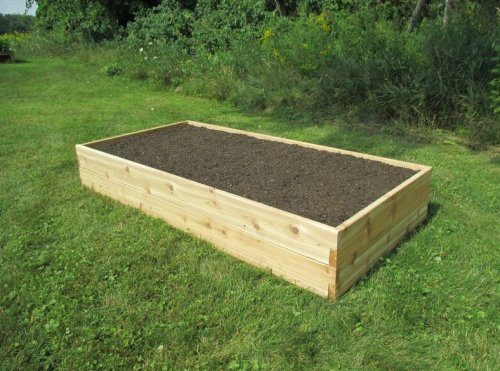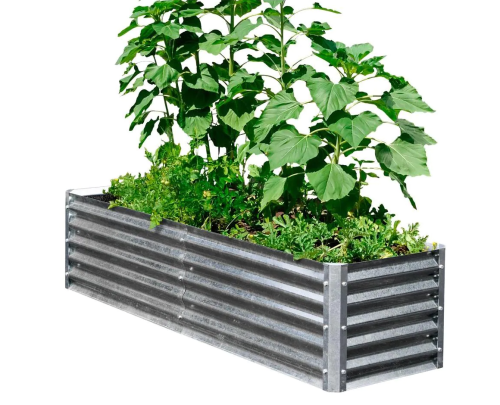Our editors independently select these products. Making a purchase through our links may earn Well+Good a commission
Here’s Why Your Vegetable Garden Could Benefit From Raised Beds—And How To Make Your Own
All the benefits of raised garden beds, from soil control to accessibility, plus ideas for adding one into your yard.

So many factors have a stake in how a vegetable garden grows, from sun exposure to soil quality to daily temperature, making it tough to know what can actually take root in your yard—not to mention the unique care that different vegetables require to reach their maximum flavor potential. Thankfully, incorporating raised garden beds into your planting plan helps minimize and even erase some of those tricky variables from the gardening equation, and puts more growing power into your own two hands.
Experts in This Article
Tara Nolan is a co-founder of the award-winning gardening website Savvy Gardening and author of the book Raised Bed Revolution on the benefits of vegetable gardening with raised beds.
Essentially, a raised garden bed is any circular or four-sided structure with an open (or draining) bottom that you fill with the soil of your choice and use as the home base for your plants. Just think of it as a more substantial version of a container garden. As a result, you can construct one in any open, outdoor area, like atop a patio or deck, making it possible to grow vibrant vegetables at home, even if you lack green space.
Because you can determine the shape and contents of the particular gardening container you choose, ideas for raised garden beds run the gamut from wooden enclosures to metal stock tanks, and they can support almost all vegetables, depending on how you plant and tend to them. Below, gardening expert Tara Nolan, co-founder of the Savvy Gardening blog and author of Raised Bed Revolution, shares more perks of using raised garden beds, and offers advice on making your own, plus three pre-made versions that can jumpstart your planting progress.
The benefits of using raised garden beds
Soil control
Unless you conduct a soil test, it’s tough to know the precise contents of your yard’s soil and what types of vegetables it can adequately support. With a raised garden bed, you’re filling the structure with the soil of your choosing, so there’s no need to figure out its makeup, nor do you have to go about amending it with organic matter, should it turn out to be rocky or rich in clay. And once you fill your raised garden bed with earth, it also stays loose and friable (so, it drains well), since you’re not walking between the vegetable rows—and trampling down the soil—as you might with a classic in-ground garden.
Another plus? With a raised garden bed, you can construct a vegetable garden where you don’t have any soil. As noted above, the bed structures are self-contained, so if you don’t have a natural spot for an in-ground garden, you can put a taller raised garden bed on a patio, driveway, or deck, says Nolan, and then you control all the rich organic matter that goes inside. (The extra height matters here, since the roots of your vegetables won’t be able to reach down past the garden bed’s contents and into the ground; scroll down to the DIY section for more details on ideal height.)
Temperature control
If you live in the northern part of the country (where it stays cool longer into the spring and gets cool earlier in the fall) and are aiming to grow vegetables with a longer growing season, a raised garden bed can help. “Soil in a raised bed warms up more quickly, so you can actually start growing sooner than you would be able to with an in-ground garden,” says Nolan.
Accessibility
Because of the height of a raised garden bed, there’s less need to crouch or get down onto the ground in order to tend to plants. “If you have trouble bending over or kneeling, a taller raised garden bed is great for bringing your vegetables within easy reach,” says Nolan. Some designs even include a small ledge or bench on the side—or, you could build one in yourself if you’re creating a DIY wooden version—so, you can comfortably sit while you water, weed, and prune.
Aesthetics
“When I first started raised-bed gardening, it was mostly for aesthetics,” says Nolan. “My house came with a lumpy uneven vegetable patch, and I had been looking for ways to make it easier on the eyes when I came across raised garden beds.” The structures help tidy up gardens into clean, geometric shapes, and keep them from becoming unruly as they grow.
How to make your own raised garden bed using wood
If you have some basic woodworking wherewithal, all you need to create your own raised garden bed are four pre-cut pieces of wood, plus a drill and a hammer to put them together into a rectangular shape (the bottom stays open). You can have wood pre-sawed to your preferred length at the lumber yard or big box store where you’re purchasing it—typically, raised garden beds are three to four feet wide, by six to eight feet long—so, you don’t need to DIY the cutting, says Nolan. She suggests opting for untreated cedar, as it’s naturally rot-resistant.
As for the vertical height of the raised garden bed’s sides, that will depend on what it’ll be sitting atop—though, the typical height is 11 to 12 inches. “If you’re putting it over soil that’s really nice and healthy underneath, the sides can be shorter because the vegetable roots will be able to reach below the framework of the raised bed into the subsoil, and not hit a brick wall, for example,”’ says Nolan. But if there’s really compacted or clay soil beneath your bed, or if it’s sitting on pavement or a driveway, you’ll want to go taller with the sides, so that the feeder roots of your plants have enough space to reach down and secure nutrients before hitting the bottom of the soil.
If you’re looking for a simpler DIY option, Nolan also suggests buying raised-bed corners, which are powder-coated steel brackets into which you can just slot your four wooden slabs (rather than having to manually secure them together).
3 different types of raised garden beds for vegetable gardening (almost) anywhere

Wayfair Danny Wood Raised Garden Bed — $200.00
This wooden option is made with red cedar, which is naturally rot resistant, and its corners are half-lapped, so that the wood pieces don’t separate over time with natural warping (due to exposure to wind and water). It’s easy to set up with the metal pins provided—no tools necessary—and comes in two sizes (square and larger rectangle).

Smart Pot Variety Pack — $30.00
Great for smaller spaces, these fabric options are a cinch to set up (just unfold and fill with soil), and can be emptied, washed, and stored for winter—making them ideal if you’re looking to grow a seasonal vegetable garden on a balcony or terrace, for example, or if you know you’ll need to dismantle and transport your garden in the near future. The fabric is durable enough to keep soil contained but also porous enough to allow for efficient drainage when watering.

EarthMark Alto Series 22 in. x 76 in. x 17 in. Galvanized Metal — $178.00
If you’re interested in a galvanized-metal raised garden bed for aesthetics or for surefire protection against warp or rotting, this option is your best bet. It’s a modular system, which allows you to slot in shorter or taller side-walls depending on what you’re growing and the height you’d like your garden bed to reach.
How to use and maintain raised garden beds
You can grow almost any vegetable in a raised garden bed, says Nolan, with the exception of perennial plants like asparagus and blueberries, for example—just because those guys might eventually outlast the lifespan of the wood.
When you first set up your raised garden beds, be sure to water every day, both because your plants are just taking root and because fresh, untouched soil typically drains very efficiently. “You might also notice that after a few summer rainstorms, your beds appear to be half full as the soil gets compacted,” says Nolan. “I always keep a couple bags of compost on reserve to top off the soil whenever that happens.”
And if you’re engaging in succession planting—for example, planting peas in the early spring and planning to pull them out before planting peppers in their place—remember to amend the soil in between, too, with some compost. “When you remove the first batch of plants, you’re taking some of the soil and its nutrients with them, so you’ll need to add some of those nutrients back into the bed in order to support your next wave of plants,” Nolan says.
And before the first frost, she suggests pulling out all your remaining plants, but leaving the soil in place. It can happily sit there until you’re ready to fill the bed the following year, so long as you perk it up with some compost when the time comes, in order to prep it for healthy planting.
Oh hi! You look like someone who loves free workouts, discounts for cult-fave wellness brands, and exclusive Well+Good content. Sign up for Well+, our online community of wellness insiders, and unlock your rewards instantly.
Sign up for the Well+Good SHOP Newsletter
Get exclusive deals on wellness, beauty, fitness, and food products that have been hand-picked by our editors.
Got it, you've been added to our email list.









